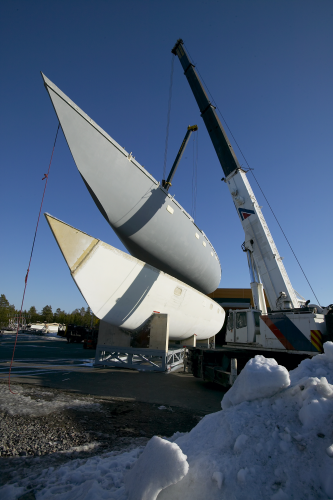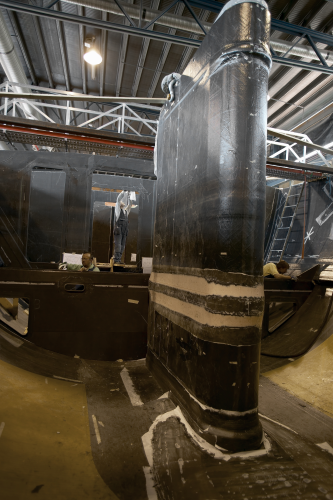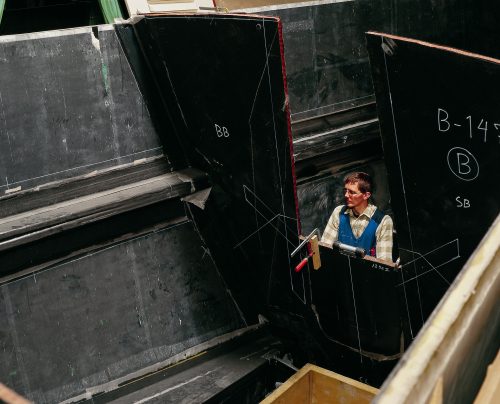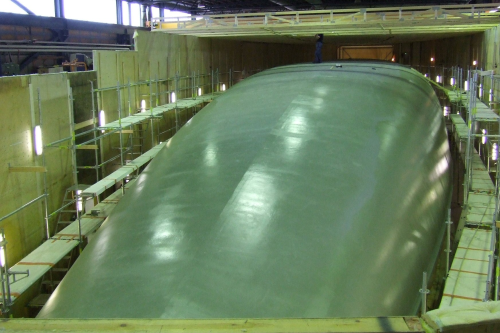



Northern Finland is home to a yacht builder that has become legendary among yachtsmen whose primary focus is cruising but who nevertheless crave top-notch performance. Baltic Yachts relies on high-tech composites when producing the strong yet light structures that enable it to meet their high expectations.
Baltic Yachts espouses the light-to-medium displacement (weight) school of yacht design. That is to say its yachts are not tore-out racers with the lowest possible weight – they are still comfortable cruisers –- but nor are they the heavy structures that, for generations, have been associated with durability and sea kindliness. The Finnish constructor argues that, today, a well conceived and constructed yacht of modest weight can provide sparkling performance without losing the traditional virtues. In proving its point, Baltic Yachts has become a prime exponent of carbon composite construction, using it both for series yachts and for bespoke one-off super cruisers that appeal to discerning individuals who can afford the privilege of ownership.
Take, for example, one of the most stunning superyacht projects in progress today, an enormous 67 m long (220 ft including bowsprit) ketch taking shape at the company’s yard in Jakobstad. Dubbed the Panamax super-ketch because it is sized to pass through the Panama Canal, the vessel is expected to weigh just 210 tons(light ship) despite having a 60 m (197 ft) long hull and a main mast that will tower 62.5 m (205 ft) high – just low enough to pass under the Bridge of the Americas at the Pacific end of the Canal. (Clearance under this bridge was one of the reasons a ketch [two-masted] rig was chosen in preference to a sloop [single mast]).
Such low weight results from fabricating the primary hull and deck structure of carbon/epoxy skins sandwiching Nomex® honeycomb and Corecell™ structural foam core. Isle of Wight, UK, based SP, the marine arm of Swiss company Gurit, is responsible for the structural engineering, working closely with the vessel’s designers, naval architects Gerard Djikstra and Reichel Pugh. The UK-based Rhoades Young partnership has come up with a composites-based interior that is extremely light while offering high comfort in an attractive retro style.
Despite visually resembling a graceful 19th century pilot cutter with long bowsprit, strong shear, high bulwarks and sculpted stern, Panamax is decidedly contemporary below the waterline. She has long flat underbody sections aft, a deep bulb keel attached to the carbon hull via a slim stainless steel foil, and the currently-fashionable plumb (vertical profile) bow. The keel can be raised to reduce draft from 9.5 m to 3.5 m. Righting moment due to the 40 ton bulb weight can be augmented by 40 tons of internal water ballast that can be pumped from side to side. The vessel, with its classic looks and many innovative features, is expected to be finished and launched in 2011.
Although Baltic Yachts is restricted by owner confidentiality from discussing the Panamax ketch in detail, Reinforced Plastics has learned that advanced materials and methods are used to keep the weight of the basic hull and deck structure down to a creditable 45 tonnes. It has built these, along with internal bulkheads, using vacuum-bagged carbon prepreg skins over Nomex and Corecell core, cure being effected by oven-baking to 85° C. Carbon prepregs, along with core materials, adhesives and epoxy laminating resins, are sourced from SP. The hull, laminated upside down over a huge composite plug, was produced at Baltic’s inland Bosund factory and was then transported to a new waterside facility on the coast at Jakobstad. The 20 km road journey necessitated removal of street lamps and road signs, plus lowering of overhead cables and the filling in of ditches to allow the low loader to pass. The deck was also laminated at Bosund, in two sections. Vessel completion is taking place at the new 5000 m2 plant, which is leased from the local authority and allows for future construction of craft up to 260 ft long.
Main and mizzen masts that are 62.5 m (205 ft) and 57.5 m (188 ft) high respectively are also carbon and will carry up to 2400 m2 (26 000 ft2) of sail, much of it in 3DL carbon. A large carbon bowsprit will be removable during periods spent in port. Standing rigging utilises PBO fibres rather than stainless steel wire or rod. According to its producer, Future Fibres, the PBO solution saves five tonnes over rod and will be the largest composite standing rigging set to date.
In the primary hull and deck structure, special engineering attention was required for areas of concentrated stress, such as around the deck apertures and in the keel area where stresses are particularly high and vary according to which of its three operating positions the hydraulically lifting keel is in at any given time.
As SP principal structural engineer Rod Fogg comments: “Designing for an ultimate grounding load of 3000 tonnes means that this could be one of the highest point loads ever experienced in composite design.”
SP had an engineer on site in Finland for a year during the most relevant part of the construction phase.
Like the main structure, the internal bulkheads are carbon sandwich constructed, high quality flat panel lamination being achieved by use of a laminating press. Other panels and furniture are similarly light cored structures. In the machinery spaces where there are onerous fire safety requirements, a special fire-retardant prepreg is used. New epoxies such as SP Systems’ ST 7 0FR have opened up opportunities for such applications.
Evolution
While innovation is a Baltic Yachts hallmark, the technology used in the Panamax super-ketch is equally the result of an evolutionary process. It is nearly seven years since the company launched Visione, a 147 ft Reichel/Pugh-designed luxury sloop that ratcheted up the state of the art in carbon sail craft construction.
Visione’s hull, deck and bulkheads are of carbon-aramid prepreg over mainly Nomex honeycomb but with some Corecell in areas of the hull subject to high slamming loads. Finite element with buckling analysis helped establish that the hull would be able to withstand high fore and aft bending loads induced by the large sloop rig and lifting keel structure. The high aspect ratio lifting keel housed in a carbon fibre reinforced plastic (CFRP) trunk stressed for an ultimate grounding load of 2000 tonnes paved the way for that on the later Panamax with its 50% higher grounding tolerance.
A predominantly high-elongation carbon fibre was used, with selective use of intermediate modulus-carbon for extra stiffening fore and aft. Both hull and deck were built over male plugs as single mouldings. Baltic prefers the male plug approach to the frequently used alternative of female-moulding hulls in two halves that are subsequently joined, both because it results in a single integral structure and because unidirectional fibres are stretched out over the plug in a well laid out fashion, something that is difficult to achieve in the concave shape of a female mould. So that the owner could have the traditional teak deck prized by yachtsmen, teak was applied over the composite deck using a thixotropic bedding epoxy as the fixing adhesive.
The disguised modernity evident in Panamax had a precedent in the Baltic 97 Pink Gin, in which the traditional sheer and long overhangs belie the high-tech carbon and aramid/epoxy sandwich structure produced by vacuum bag lamination. The carbon skins sandwich a DIAB Divinycell foam core. Designed for a German owner by Rolf Vrolijk, the result of this approach, along with structural design by SP Technologies, was a net structure weight of 21 tons for the 29.65 m (97 ft) craft. A Southern Spars mast, plus furling foils and boom vang, were also of carbon.
Baltic Yachts was an early adopter of pre-pregging methods as a means to maximise strength-to-weight. Prepregs used to construct the same German owner’s successor craft, the 152 ft Pink Gin 2, enabled the combined weight of the carbon hull, deck, bulkheads and stiffening framework to be held down to about 35 tons. Total displacement of some 180 tons compares well with a weight of around 220 tons for a similar sized yacht constructed using conventional materials and techniques.
Baltic’s production team has worked hard over the years at refining its processes, for instance maximizing prepreg fibre-to-resin ratios, achieving high levels of vacuum and controlling zonal temperatures accurately for perfect results. Acquisition by the company in 2001 of a 40 tonne laminating press made it possible to produce flatter, lighter structural bulkheads and other interior panels than can be achieved with vacuum bagging.
Innovations for Pink Gin 2 included a Kevlar backstay, two cockpits and extensive use of Tuff Mass, a vinyl barrier, throughout the accommodation for restricting air and structure-borne noise. Acoustic control has become a considerable issue with carbon craft in which, due to the material’s stiffness, hull and deck structures can be likened to the sound box of a stringed musical instrument, amplifying the slightest sound. Teak veneered carbon sandwich is used for the dining table and other major furniture, while even the interior grab rails are of carbon composite tubes finished with a teak veneer. A deep iron bulb keel attached with a high-tensile stainless steel fin, along with carbon blade style rudder, contribute to the vessel’s high performance.
Low weight focus
Baltic Yachts set out on the custom yacht building road in 1973 and has since constructed craft ranging in overall length from 11.5 m (38 ft) to 60 m (197 ft). Customers who demand the highest standards of construction and performance and are able to pay for them enabled the company to take an innovative stance encompassing the development of new techniques and materials.
Per Goran Johansson, until recently marketing director (now succeeded by Kenneth Nyfelt) and a key driver of low-weight technical solutions, was clear that composites were crucial, enabling mass to be minimised without sacrificing strength and safety. Moreover, as he perceived, high-tech materials and building methods also provide a higher general quality and better durability.
Johansson, for whom weight is an almost tangible enemy, contends that saving weight in the primary structure has iterative benefits. For example, if a given ballast/displacement ratio is to be maintained, weight in the keel can be reduced. Less keel weight can be balanced by reduced sail area, hence lower masts. (The keel acts to hold the yacht upright against wind pressure on the sails.) This means that the rig and its fittings can be less substantial because they carry less load. Consequently, weight aloft is reduced. Designers can then go back to the keel and subtract more weight, thereby starting round the ‘mathematical circle’ again. Baltic says that, thanks to this iterative effect, taking 500kg of weight out of the primary structure can result in a total weight saving up to four times this for the finished craft, maintaining the same ballast/displacement and sail area/displacement ratios.
All Baltic yachts have a high-quality technical laminate. Some standard models, like the Baltic 64, are constructed using vacuum bagged laminate, typically with end-grain balsa as a core and hybrid glass/aramid as the fibre element. In the larger custom vessels, the technology moves up a gear to high-standard (but costly) unidirectional carbon/epoxy using low, intermediate and high-modulus fibres in prepreg form. At this level, cores are of Nomex honeycomb and the highly resilient styrene-acrylonitrile (SAN) structural foam Corecell.
Baltic Yachts has favoured sandwich construction from the start, for its strength, stiffness, lightness and insulation. Because the stiffness of a panel is proportional to the cube of its thickness, a sandwich panel will be much stiffer, with less flexing, than a single-skin laminate. Baltic holds that this prolongs the life of the laminate, resisting the formation of stress cracks and consequent water penetration. Its experience is that the strength of a laminate dramatically decreases with panel flexing.
An early adopter of technical fabrics, Baltic generally prefers unidirectional fibres to wovens for the hull and deck structure. Unidirectionals, it says, enable fibres to be aligned closely with the load paths. They are stronger than wovens because they lack the weave’s fibre undulations that are subject to stretch, resulting in unequal load bearing by the fibres. Woven-based laminates therefore tend to flex more, allowing microscopic cracks to form. Baltic argues that in a unidirectional laminate the fibres bear the load equally, resisting stretch and maintaining panel stiffness.
While it is convinced that unidirectional laminates outperform any other configuration in terms of minimum thickness, strength-to-weight ratio and fibre-to-resin ratio, Baltic concedes that they do require high-level know-how from the builder. Laminates are built up by running different unidirectional layers in different directions according to the load paths.
Unidirectionals traditionally used at Baltic have been a special aramid/glass roving, but today they are increasingly of carbon. Whereas the company uses vacuum bag lamination for its standard yachts and smaller custom/semi-custom products, prepregs are the basis for the larger bespoke craft. The company contends that, of all the laminating methods, prepregs offer the best control of resin ratio plus optimised orientation of straight fibres. Most of the vessels produced by the Custom Yacht Division today are in prepreg – using mainly carbon but also aramid and S-glass fibres. Carbon predominates in the larger megayachts where stresses are especially high.
Resin
Equal care is taken over resin selection and optimisation. In the hierarchy of boatbuilding resins – orthophthalic polyester, isophthalic polyester, vinyl ester and epoxy – the last named best fulfils the basic purpose of the resin phase, gluing together the fibres which are the composite’s main load bearing elements and keeping the fibres in column when they are under load. Baltic Yachts is clear that epoxy has the best adhesive properties and maintains them the longest.
The company also stresses the importance of the resin’s elasticity (elongation to break) in optimising laminate strength. Ideally, resin and fibres should be well matched in this respect. Technicians point out, for example, that an E-glass/orthophthalic polyester laminate will, when stressed, break at a point where only about a third of the strength potential of the glass fibres is used. The laminate fails due to failure of the resin, not the fibre. If, however, epoxy were to be used instead of polyester, all of the E-glass fibre strength potential would be harnessed because epoxy’s maximum elongation exceeds that of the glass. Epoxy is also a suitable basis for prepregs as it can be partially cured, to the Beta stage, for use in storable sheet material. Later, once the lay-up is complete, it can be fully cured under vacuum and at high temperature, typically 85°C in marine construction.
Future confidence
Led by managing director Lisbeth Staffans, Baltic Yachts continues to invest in innovation for the future. For example, it believes that use of carbon nanotubes in nano-epoxy resin holds great promise for stronger laminates and is in the early stages of their application. It continues to refine its use of prepreg and resin infusion techniques as those best suited to the production of large, top-quality yachts. Its own engineering resources are boosted by those of R&J Design, an associate company that is co-located at Bosund and works closely with Baltic.
Thanks to composites, Baltic’s customers acquire something of lasting value.
As one spokesman puts it: “We strongly believe that a sensible high-tech laminate will be stronger, lighter and more durable, increasing the life of a yacht and making it a good investment for the owner.”
From the several large yachts currently in build and the number of projects in the pipeline, it seems that Baltic Yachts may be able to buck the recession, particularly with its custom-built performance cruisers. Fortunately, a seemingly steady supply of wealthy individuals lust after the carbon sailing gems that the Finnish constructor has become known for.






